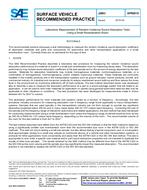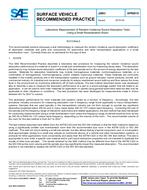Click here to purchase
This SAE Recommended Practice describes a laboratory test procedure for measuring the random incidence sound absorption performance of a material or a part in a small size reverberation room by measuring decay rates. The absorption performance may include sound absorption coefficient of the test sample and or the amount of energy absorbed by the test sample. Materials for absorption treatments may include homogeneous materials, nonhomogeneous materials, or a combination of homogeneous, nonhomogeneous, and/or inelastic impervious materials. These materials are commonly installed in the mobility products and in the transportation systems such as ground vehicles, marine products, aircraft, and commercial industry (in industrial and consumer products) to reduce reverberant sound build-up and thus reduce the noise level in the environment by minimizing reflections off of hard surfaces. The test method described herein was developed also to describe a way to measure the absorption performance of a part or a sound package system that will relate to an application. It can be used to rank order materials for application on panels using general automotive steel but also may be applicable to other situations or conditions. This test procedure has been developed for measurements made in rooms between 6m3 to 25m3 in volume. The absorption performance for most materials and systems varies as a function of frequency. Accordingly, this test procedure includes provisions for measuring absorption over a frequency range found applicable to many transportation systems. Samples that are used typically in the transportation industry are not thick enough to provide any significant absorptive properties below 250 Hz and in many cases below 400 Hz 1/3rd octave band frequency. Combining the size of the sample and the frequency range of interest for automotive and related applications, this test method has been developed for conducting measurements using a small reverberation room where the frequency range of interest would be from as low as 250 Hz to 8000 Hz 1/3rd octave band frequency, depending on the volume of the room. The recommended volume of the room for this test method is from 6m3 to 25m3. The test method described here differs from the ASTM C423 and the ISO 354 methods in that the SAE method is based on using a significantly smaller size reverberation room than the recommended size room in the ASTM C423 or ISO 354 methods. This aids not only to testing a small size sample, but also allows testing a typical component, part, or a subsystem (that approximates closely to a small size sample as mentioned above) of a vehicle and other transportation systems, or products for other applications more conveniently and easily than the ASTM C423 or the ISO 354 test method. This test is appropriate to rank order a specific size material and/or part sound absorption properties and not intended to duplicate the results of other size samples. The results obtained by the SAE method may be different from that of the ASTM C423 or the ISO 354 as the room volume and the sample size may significantly impact the measured absorption. This recommended practice is not intended to replace the ASTM C423 or the ISO 354 test standard.
Product Details
- Published:
- 04/30/2015
- File Size:
- 1 file , 480 KB

